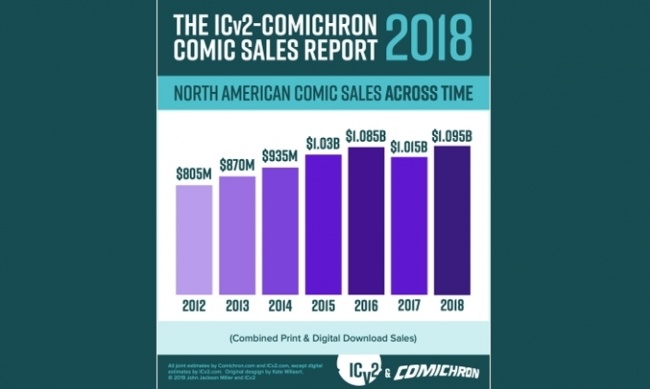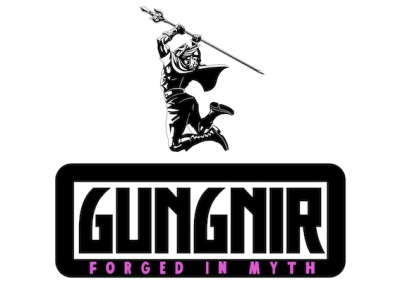An ICv2 Release. Comics and graphic novel sales hit a new high in 2018, according to a new joint estimate by ICv2’s Milton Griepp and Comichron’s John Jackson Miller. Total comics and graphic novel sales to consumers in the U.S. and Canada were approximately $1.095 billion in 2018, an $80 million increase over sales in 2017. The increase was due to gains in book channel and digital sales (see "Digital Comic Sales Growing Again"), and the inclusion of an estimate for U.S. and Canada sales through crowdfunding sites for the first time.
"After a brief downturn in 2017, the market bounced back last year," Miller said. "Popular releases helped right the ship in comics shops, even as other sales avenues made significant gains."
"A historic shift is playing out as the market grew, primarily in the book channel, in 2018," Griepp said. "While comic stores are still the largest channel, they represented less than half the market for comics and graphic novels in 2018 for the first time in at least three decades."
Sales in the book channel, which includes chain bookstores, mass merchants, major online retailers, and Scholastic Book Fairs, were up by double digits, with sales of kids graphic novels the biggest factor. Digital sales were also up for the first time in several years, with increased title counts across multiple platforms a factor. Sales in comic stores were down very slightly versus the previous year.
Sales of all three formats, comics, graphic novels, and digital, grew in 2018, with graphic novels leading the way, followed at some distance by digital and comics.
As presented above and in the accompanying infographics, the analysis by Comichron and ICv2 was divided up between periodical comics (what some call "floppies” or “pamphlets"), graphic novels, and digital download-to-own sales. All print figures are calculated based on the full retail price of books sold into the market, and do not account for discounting or markup. Digital sales do not include subscription-based "all you can read" services.
We’ve added a new category, "Other" to our channel breakdown. "Other" includes the Newsstand (periodical sales through specialty retail and mass merchant chains) and Crowdfunding (Kickstarter, etc.) channels. This year, those two channels each accounted for roughly half of the "Other" category.
Sources for the information include NPD BookScan, which collects weekly point-of-sale data on print books from over 16,000 locations including e-tailers, chains, mass merchandisers, independent bookstores, and more. NPD BookScan covers approximately 85% of the U.S. trade print book market. Some publishers classify titles that are primarily text, or art books, as graphic novels; we remove those titles from our analysis.
The analysis also incorporates information released by Diamond Comic Distributors, the largest distributor of English-language comics and graphic novels in the world, on sales to comic stores.
Information is also gathered from a variety of other sources, including publisher, distributor, and retailer interviews.
This is the sixth joint market size analysis from ICv2 and Comichron; the first was for 2013 sales.
Click on the Gallery below to see the Comic Sales Report graphs for 2018.
ICv2
ICv2 is the #1 industry source on the business of geek culture, including comics and graphic novels, hobby games, and showbiz on its website, www.ICv2.com, and in its magazine, Internal Correspondence. For the people on the front lines of the geek culture business, staying ahead of the trends isn't something that can be left to chance-it's a basic necessity for being successful. That's why ICv2 is the #1 source of news and information for the buyers, gatekeepers, and tastemakers on the front lines. ICv2 is where trend-watching is a science.
Comichron
Comichron is the world's largest public repository of comic-book sales figures, featuring data from the 1930s to today about comic book and graphic novel circulation, cover prices, and market shares on its website, www.comichron.com. With data and analysis on the distant past as well as the present, Comichron serves as a trusted resource for academics studying the historical reach of the medium and for collectors seeking accurate information about how many copies of a comic book originally circulated.

According to New Estimate by ICv2 and Comichron
Posted by Milton Griepp on May 2, 2019 @ 1:01 pm CT
MORE COMICS
New Miniseries Set in the Ruins of Notorious Jim Crow Mental Hospital
August 18, 2025
The story revolves around the real-life Crownsville psychiatric hospital in Maryland, a segregated facility that was notorious for the mistreatment of its patients.
Publisher Founded by Former Heavy Metal CEO to Expand with Three Imprints
August 15, 2025
The publisher, founded by former Heavy Metal CEO Michael Medney, will expand with three new imprints.
MORE MARKETS
Superheroes are Fresh, Author Titles are Stale, and Manga Just Keeps Plugging Along
August 14, 2025
DC Comics' Compact Comics and Marvel Comics' Premier Editions take over the Superhero chart with a flurry of newer titles, while the Author chart has just one new release.
New Anime Drive Manga, Everyone Loves the Turtles, 'Solo Leveling' Is Missing
August 12, 2025
New anime propelled two manga onto the chart for the first time, a new TMNT hardcover appears, and for the first time in a long time, Solo Leveling is absent from the Top 20.



 View Gallery: 4 Images
View Gallery: 4 Images 



